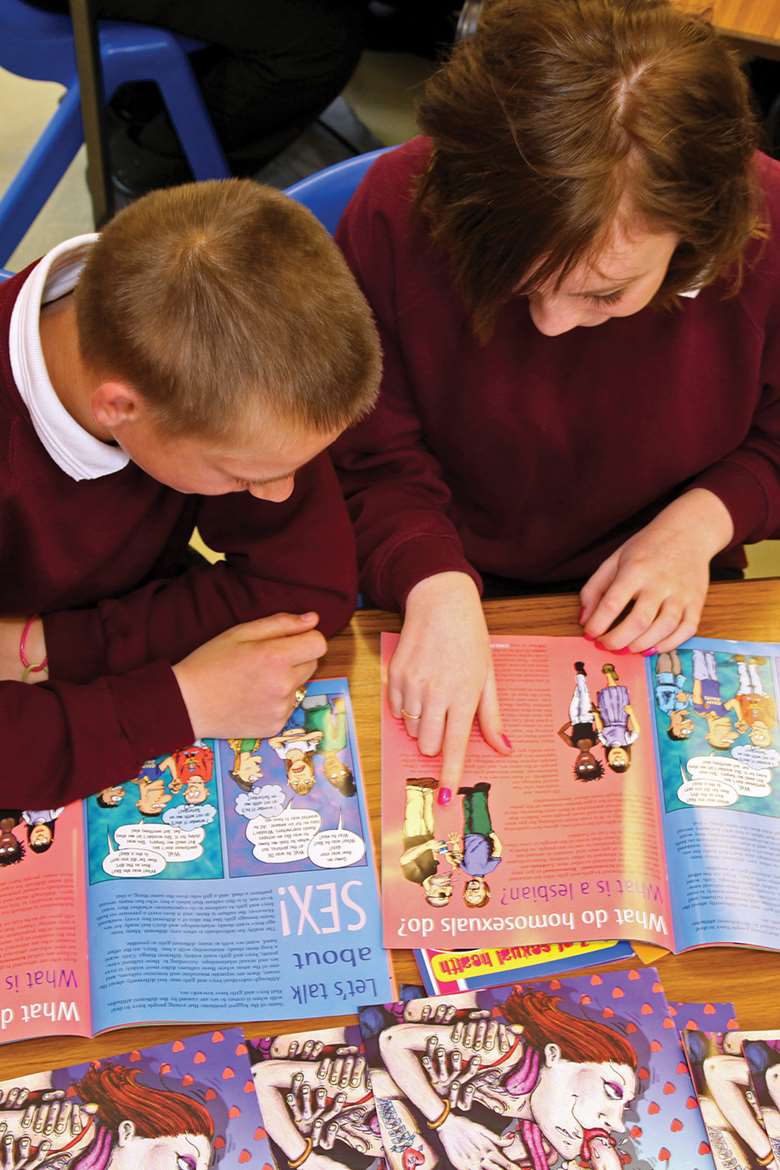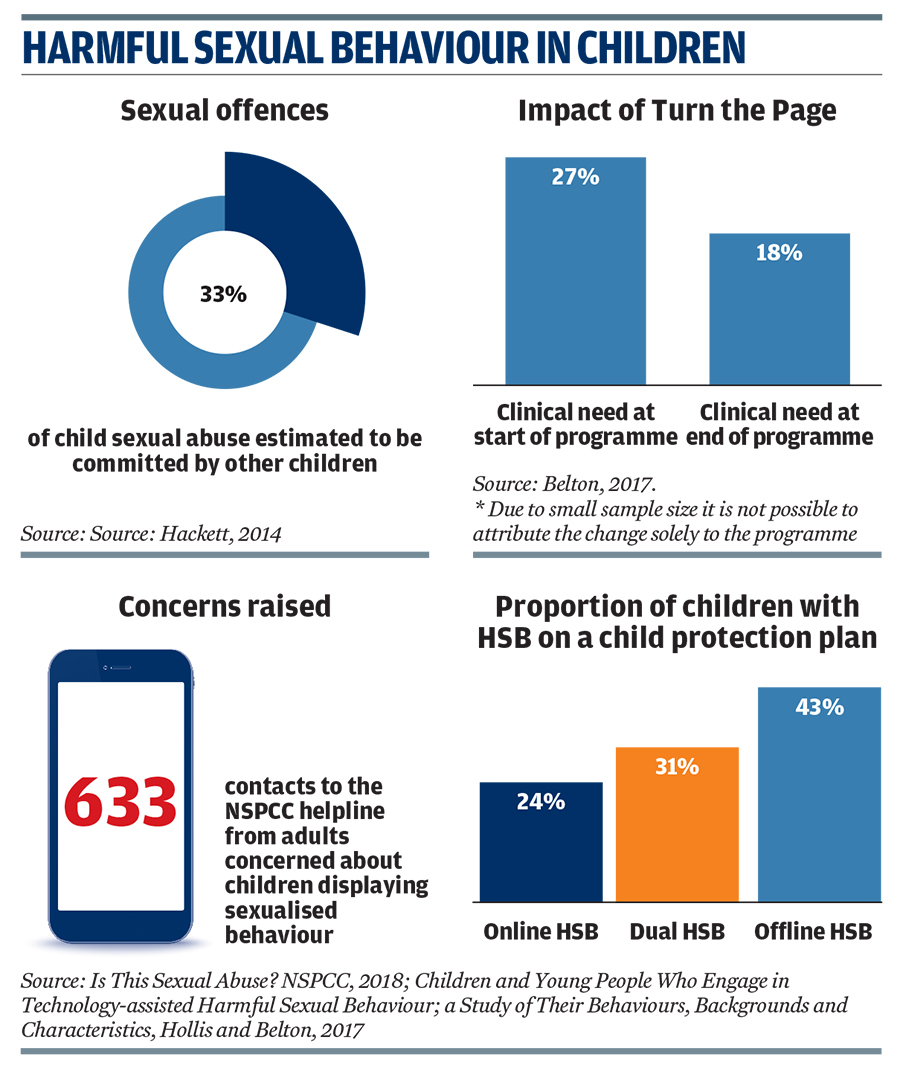Evidence and Impact: Harmful sexual behaviour
NSPCC
Tuesday, May 29, 2018
The latest in a series of articles about emerging safeguarding practice looks at how the NSPCC has developed evidence-based approaches to help professionals respond to harmful sexual behaviour.

The NSPCC works with children, young people and families who need help across the UK. Its services aim to protect children today, prevent abuse tomorrow and support wider efforts to make child cruelty a thing of the past. To improve understanding of best safeguarding practice, the NSPCC publishes evaluations of its services and interventions, and undertakes research and literature reviews. These are published on the NSPCC website (www.nspcc.org.uk/evidence) to contribute to the evidence on what works to protect children and families.
A 2014 study by Hackett found that around a third of child sexual abuse is committed by other children and young people. In light of this, NSPCC carried out research to build the evidence base about what works to prevent and manage harmful sexual behaviour (HSB). It found that many professionals lack the confidence to respond effectively to HSB.
Learning points
Responding to each child's needs
The NSPCC evaluated how the Change for Good manual was used with males aged 12-18. The manual enables practitioners to explore the social and emotional challenges a young person is facing, help children change their behaviour and improve their wellbeing.
It forms the basis of Turn the Page, an evidence-based therapeutic intervention for children and young people who display HSB that has been developed by the NSPCC.
The evaluation by Belton (2017) found that the boys taking part in the programme often faced complex circumstances in addition to their HSB, for example problems at school or difficult relationships with parents or carers. The boys said they didn't always have someone to talk to about their problems, so the regular sessions with practitioners were helpful. Practitioners also felt it was important to be able to use the Change for Good manual flexibly, to respond to each individual boy's needs.
The NSPCC also used Turn the Page to work with girls, children under 12, and children with learning difficulties. The evaluation, by Hollis (2017) showed the importance of having a flexible approach to assessment and service delivery to enable practitioners to recognise and respond to the range of difficulties children might display. However, practitioners felt they needed more guidance about the best ways to address HSB amongst these groups of children.

Recognising online HSB
A literature review and research exploring technology-assisted HSB (TA-HSB) - through online and mobile channels - highlighted a lack of information, guidance and support for professionals working with children and young people displaying this behaviour. The research by Belton and Hollis, found:
Professionals seemed to take a more punitive approach towards children displaying this form of HSB and a more therapeutic approach to those who displayed offline HSB
When asked by researchers to classify the types of HSB displayed by children, practitioners overlooked almost half of the TA-HSB displayed by children who showed both offline and TA-HSB.
This may be because therapeutic services and assessment tools tend not to focus on the role of technology. Professionals also appeared to lack knowledge, guidance and confidence in understanding and recognising harmful sexual behaviours that are displayed in an online environment.
Post-intervention support
It is crucial for young people to have support after a service ends, to reinforce the messages from the programme and help manage any ongoing difficulties. Although young people made good progress with Turn the Page, some struggled to apply the messages they had learned after the programme ended. Some of the agencies that had referred the young person to the service closed the case soon after the intervention finished, and parents or carers didn't always have the capacity to provide the support young people needed.
For the Turn the Page evaluation, professionals who referred children to the service said they needed a better understanding of how the programme works and what practitioners were focusing on in each session, so they could provide effective post-intervention support. Some also felt they lacked knowledge about how to help the young people manage their behaviour.
Evidence into practice
Tailored intervention support
Using evidence, plus recommendations from bodies such as the National Institute for Health and Care Excellence has enabled the way interventions can be tailored to meet the differing needs of children and young people displaying harmful sexual behaviour. The NSPCC offers:
- Change for Good A manualised treatment programme for young people aged 12 to 18 who are displaying harmful sexual behaviour.
- Be Safe A programme for children aged six to 12 that uses cognitive behavioural therapy. It is also delivered as a family intervention with parents/carers.
- Good Way Model An intervention for young people who have mild to moderate intellectual or learning difficulties and also display harmful sexual behaviour.
The NSPCC and the AIM Project have been working together to develop practice guidance and a training package to help practitioners understand TA-HSB. This includes an assessment tool for use with adolescent males who display TA-HSB.
Local area responses
The NSPCC worked in partnership with Research in Practice and Durham University to develop the harmful sexual behaviour framework, with input from a range of service delivery organisations. The framework aligns with guidelines from the National Institute for Health and Care Excellence and aims to help local areas develop and improve multi-agency responses to tackling HSB. It focuses on five key areas that are closely interrelated:
- A continuum of responses to children and young people who display HSB
- Prevention, identification and early assessment
- Assessment and referral pathways
- Interventions
- Workforce development.
The framework is being delivered in 10 early adopter sites. Evidence suggests it helps organisations to:
- Maintain focus on the process of adopting the framework
- Link their HSB response to child sexual exploitation initiatives
- Gain leverage and support for the work being carried out
- Understand how their local area fits with the national picture.
In addition, the NSPCC was commissioned by the NHS National Workforce Skills development unit to produce a version of the HSB framework for the health sector in 2018.
National policy framework
It is 26 years since the committee of enquiry into children and young people who sexually abuse other children proposed a national strategy to address HSB in the UK (NCH, 1992). But service provision for HSB remains patchy and relatively unco-ordinated. Levels of professional confidence and competence to address the challenge vary (HMP Probation et al, 2013). A more co-ordinated approach, that recognises both the risks and needs of children displaying HSB, is needed.
The NSPCC has developed a public health approach to help prevent HSB from happening, as well as helping children who have already displayed concerning sexualised behaviour.
Sexualised behaviour in schools
In 2016/17, there were 663 contacts to the NSPCC helpline from adults who were concerned about children displaying sexualised behaviour. Many of the teachers who contacted it were unsure about how to manage incidents of sexualised behaviour and were confused about when to involve statutory agencies.
The NSPCC is part of a Department for Education working group to support the development of new statutory guidance on sexual violence and sexual harassment in schools and colleges in England.
The introduction of statutory relationships and sex education in all schools from 2019 will ensure that all young people are taught about keeping safe, healthy bodies, and healthy relationships.
However, teachers will require the training and confidence to deliver high-quality, evidence-based lessons about sex and relationships, and respond to any incidents of sexualised behaviour that might occur.
FURTHER READING
- Clinical psychologist Oliver Eastman talks about HSB and the role of technology, NSPCC video youtube.com watch?v= lAfMww6DFY4
- Managing Sexualised Behaviour in Primary Schools, NSPCC, 2018
- "Is This Sexual Abuse?" NSPCC Helplines Report: Peer Sexual Abuse, NSPCC, 2018
- Turn the Page: final evaluation, Belton, 2017
- The Profile of the Children and Young People Accessing an NSPCC Service for Harmful Sexual Behaviour, Hollis, 2017
- Children and Young People Who Engage in Technology-Assisted Harmful Sexual Behaviour; a Study of their Behaviours, Backgrounds and Characteristics, Hollis and Belton, 2017
- Harmful Sexual Behaviour Framework, NSPCC, 2016
- A Review of the Research on Children and Young People Who Display Harmful Sexual Behaviour Online, Belton and Hollis, 2016




